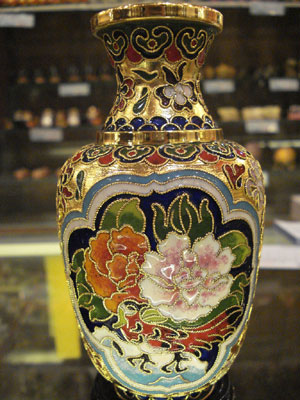|
Chinese Cloisonne
Cloisonné is well-known traditional enamelware with a history that dates back more than 500 years. It is often called the "Blue of Jingtai" for two reasons. First, blue is the most commonly used color in enameling and secondly, cloisonné became prevalent during the reign of Jingtai (1450-1456) during the Ming dynasty. Thanks to its brilliant color and splendid designs, cloisonné is highly valued in China and abroad. Making cloisonné is a complicated process that consists of six steps: base-hammering, soldering, enamel-filling, enamel firing, polishing and gilding. 1. Base-hammering Copper is used to make the body of cloisonné because it can be easily hammered and stretched. This step determined the piece’s thickness and weight. 2. Filigree Soldering In this step, the the cloisonné craftsman adheres copper strips onto the body in a manner similar to embroidery. Measuring only 1/16 inches wide, these strips are placed onto the body in a complicated design. 3. Enamel Filling This next step requires basic elements like boric acid, saltpeter and alkaline. Different elements are used to make different colors. Iron produces gray, uranium creates yellow, chromium produces green, bronze makes blue, zinc creates white and gold or iodine produce red. Workers grind these materials into fine powders and then apply them onto the cloisonné. 4. Enamel Firing Next, the cloisonné is fired and hardened. Enamel refilling is repeatedly required during this step, as heat from the fire causes the enamel to slightly sink. 5. Polishing To make the piece even, the artisan has to polish the product again and again during firing. The first material used is emery while the second is whetstone. Lastly, a piece of hard carbon is used to give the piece luster. 6. Gilding Finally, craftsmen place the cloisonné in gold or silver fluid with an electric current to keep it from rusting. After more electroplating and a slight polish, the piece is completed.
|
| Copyright © China.org.cn. All Rights Reserved 京ICP证 040089号 京公网安备110108006329号 网络传播视听节目许可证号:0105123 京公网安备110108006329号 京网文[2011]0252-085号 |

 0
0 








Go to Forum >>0 Comment(s)